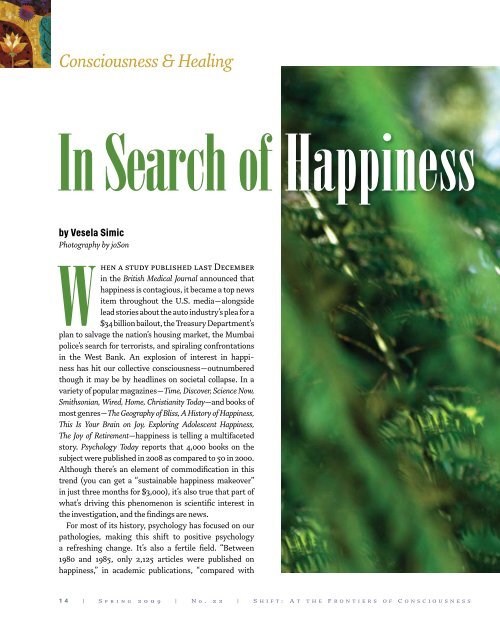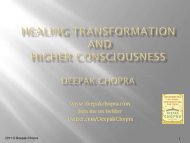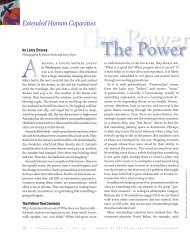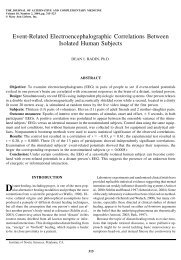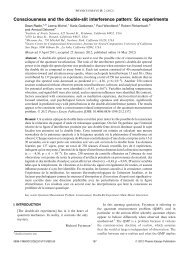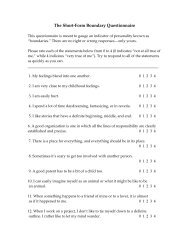Consciousness & Healing - Institute of Noetic Sciences
Consciousness & Healing - Institute of Noetic Sciences
Consciousness & Healing - Institute of Noetic Sciences
Create successful ePaper yourself
Turn your PDF publications into a flip-book with our unique Google optimized e-Paper software.
<strong>Consciousness</strong> & <strong>Healing</strong><br />
In Search <strong>of</strong><br />
by Vesela Simic<br />
Photography by joSon<br />
When a study published last December<br />
in the British Medical Journal announced that<br />
happiness is contagious, it became a top news<br />
item throughout the U.S. media—alongside<br />
lead stories about the auto industry’s plea for a<br />
$34 billion bailout, the Treasury Department’s<br />
plan to salvage the nation’s housing market, the Mumbai<br />
police’s search for terrorists, and spiraling confrontations<br />
in the West Bank. An explosion <strong>of</strong> interest in happiness<br />
has hit our collective consciousness—outnumbered<br />
though it may be by headlines on societal collapse. In a<br />
variety <strong>of</strong> popular magazines—Time, Discover, Science Now,<br />
S mithsonian, Wired, Home, Christianity Today—and books <strong>of</strong><br />
most genres—The Geography <strong>of</strong> Bliss, A History <strong>of</strong> Happiness,<br />
This Is Your Brain on Joy, Exploring Adolescent Happiness,<br />
The Joy <strong>of</strong> Retirement—happiness is telling a multifaceted<br />
story. Psychology Today reports that 4,000 books on the<br />
subject were published in 2008 as compared to 50 in 2000.<br />
Although there’s an element <strong>of</strong> commodification in this<br />
trend (you can get a “sustainable happiness makeover”<br />
in just three months for $3,000), it’s also true that part <strong>of</strong><br />
what’s driving this phenomenon is scientific interest in<br />
the investigation, and the findings are news.<br />
For most <strong>of</strong> its history, psychology has focused on our<br />
pathologies, making this shift to positive psychology<br />
a refreshing change. It’s also a fertile field. “Between<br />
1980 and 1985, only 2,125 articles were published on<br />
happiness,” in academic publications, “compared with<br />
Happiness<br />
14 | Spring 2 0 0 9 | N o . 2 2 | S H I F T: A T T H E F RONTIERS OF C ONSCIOUSNESS<br />
Sakshat Corbit
Spring 2 0 0 9 | N o . 2 2 | S H I F T: A T T H E F RONTIERS OF C ONSCIOUSNESS | 15<br />
©joSon/Corbis
COnSCIOUSneSS & HeALInG<br />
“Happiness is a skill,”<br />
says the happiest man in the world.<br />
10,553 on depression,” according to the Los Angeles<br />
Times. By 2005, the number <strong>of</strong> articles on happiness had<br />
increased sixteen-fold. Reflecting the multidisciplinary<br />
research and discussion under way, a recent conference<br />
in San Francisco titled “Happiness and Its Causes”<br />
brought together experts in psychology, neuroscience,<br />
neurobiology, internal medicine, and integrative<br />
medicine. They joined educators; public activists; artists<br />
represented by film, song, dance, drum, and judo; and<br />
scholars <strong>of</strong> philosophy and religion to shed light on<br />
the subject.<br />
What is meant by happiness, anyway? The ancient<br />
Greeks were guided by the term eudaimonia, which<br />
translates to “human flourishing.” Eastern traditions,<br />
such as the philosophies <strong>of</strong> Buddhism and Yoga, speak<br />
<strong>of</strong> happiness as the “cessation <strong>of</strong> suffering.” From<br />
these perspectives, what is sought in happiness is not<br />
transient pleasure but rather a deep sense <strong>of</strong> serenity and<br />
fulfillment. So, where can we find it? How do we get it?<br />
“Happiness is a skill,” says the happiest man in the world,<br />
Matthieu Ricard. A Buddhist monk and close associate<br />
<strong>of</strong> the Dalai Lama, Ricard was pronounced “happiest<br />
man in the world” when extensive neuroimaging <strong>of</strong><br />
his brain at the University <strong>of</strong> Wisconsin registered the<br />
highest level ever recorded (<strong>of</strong>f the scale) in the area <strong>of</strong><br />
the brain associated with positive emotions.<br />
The science bears out Ricard’s understanding <strong>of</strong><br />
happiness with its findings that 50 percent <strong>of</strong> our<br />
happiness is genetic, 10 percent circumstantial, and 40<br />
percent in our hands to skillfully cultivate. Studies have<br />
also identified a variety <strong>of</strong> intentional activities that<br />
boost our well-being: nurturing social connections; expressing<br />
gratitude; positive thinking; forgiveness; acts<br />
<strong>of</strong> kindness; living in the present as well as working<br />
to achieve meaningful goals that put us in the flow;<br />
physical activities to nurture the body; mind training,<br />
or meditation (the skill Ricard has mastered and<br />
recommends); and belief in a higher power or purpose.<br />
Money, however, doesn’t buy true happiness; this is<br />
no longer just an adage but the empirical outcome <strong>of</strong><br />
researchers’ studies. Once our security needs (food,<br />
shelter, and safety) have been met, more material<br />
wealth doesn’t guarantee more happiness. In fact, studies<br />
show that materialistic values are a strong predictor<br />
<strong>of</strong> unhappiness. Similarly, studies show that physical<br />
beauty also does not ensure greater happiness.<br />
Researchers have also observed something they’ve<br />
named “hedonic adaptation.” Human beings adapt to<br />
favorable changes; for example, getting married, more<br />
wealth, a better job, good health, and beautiful housing<br />
only temporarily boost happiness levels. The familiar<br />
example <strong>of</strong> this phenomenon is the lottery winner.<br />
Studies show that winners’ levels <strong>of</strong> happiness jump<br />
up when the money is first won but return to baseline<br />
less than a year later. Hedonic adaptation <strong>of</strong>ten<br />
works the other way, as well. Although most people’s<br />
baseline levels <strong>of</strong> happiness drop when they experience<br />
a debilitating accident or illness, with time most<br />
people recover the baseline levels they had before the<br />
event. “We cannot and will not adapt to everything,”<br />
says Sonja Lyubomirsky, pr<strong>of</strong>essor <strong>of</strong> psychology at<br />
University <strong>of</strong> California, Riverside, “but the evidence for<br />
hedonic adaptation, especially with regard to positive<br />
events, is very strong.” The implication is that positive<br />
changes in our circumstances cannot be counted on to<br />
lead to enduring happiness. Like Ricard, Lyubomirsky<br />
emphasizes that it’s ongoing intentional activities that<br />
make a sustainable difference.<br />
Ed Diener, pr<strong>of</strong>essor <strong>of</strong> psychology at the University<br />
<strong>of</strong> Illinois and one <strong>of</strong> the leading and earliest researchers<br />
on happiness, has a list <strong>of</strong> important things science<br />
has learned about “subjective well-being” (SWB, or<br />
happiness). He notes, for example, the following:<br />
• The components <strong>of</strong> SWB can be measured with<br />
some scientific validity.<br />
• Temperament is an important predictor <strong>of</strong> a<br />
person’s SWB, but some conditions (such as<br />
unemployment or living in a poor nation) have<br />
long-lasting effects.<br />
16 | Spring 2 0 0 9 | N o . 2 2 | S H I F T: A T T H E F RONTIERS OF C ONSCIOUSNESS
• Happiness correlates with desirable consequences,<br />
such as sociability, creativity, better marriages,<br />
better work performance, stronger physical immunity,<br />
and resilience in the face <strong>of</strong> adversity.<br />
• Some cultures have higher levels <strong>of</strong> happiness than<br />
other cultures. One reason seems to be that in some<br />
cultures happiness is valued more.<br />
• People in unstable and very poor societies avow<br />
lower levels <strong>of</strong> happiness.<br />
• Most people are at least slightly happy, but everyone<br />
has up and down moods; no one is happy every<br />
moment. Even the happiest people sometimes<br />
get unhappy.<br />
• Enduring happiness comes not from running the<br />
hedonic treadmill but from working for goals that<br />
are consistent with our cherished values.<br />
In short, there seems to be no single key to happiness;<br />
a variety <strong>of</strong> factors are at play for us all. “We have learned<br />
some important things about subjective well-being, but<br />
there is much that is still uncertain,” says Diener.<br />
Feeling What Is Real<br />
Despite all the feel-good research on happiness, there has<br />
also been a backlash to the scrutiny and preoccupation.<br />
In his book Against Happiness, Eric Wilson, a pr<strong>of</strong>essor<br />
<strong>of</strong> English at Wake Forest University, makes a case<br />
for our more sober emotions and their “integral place<br />
in the great rhythm <strong>of</strong> the cosmos.” Melancholia, for<br />
example, is the source <strong>of</strong> much <strong>of</strong> our great art, poetry,<br />
and music. “The blues can be a catalyst for a special kind<br />
<strong>of</strong> genius,” Wilson points out, “a genius for exploring<br />
dark boundaries between opposites.” And as Aldous<br />
Huxley’s hero John the Savage put it when he recoiled<br />
from the monotonously cheery, pleasure-principled,<br />
soma-treated society in Brave New World: “I don’t want<br />
comfort. I want God. I want poetry. I want real danger.<br />
I want freedom. I want goodness.”<br />
In their 2007 book, The Loss <strong>of</strong> Sadness, Jerome<br />
Wakefield and Allan Horwitz examine “how psychiatry<br />
has transformed normal sorrow into depressive disorder.”<br />
Wakefield, pr<strong>of</strong>essor <strong>of</strong> social work at New York<br />
University, and Horwitz, dean <strong>of</strong> social and behavioral<br />
sciences at Rutgers University, argue that the American<br />
Psychiatric Association’s Diagnostic and Statistical<br />
Manual <strong>of</strong> Mental Disorders defines major depression in<br />
terms that, except for the death <strong>of</strong> a loved one, do not<br />
contextualize the differences between dysfunctional<br />
states <strong>of</strong> depression and those brought about by hardship<br />
and stress. Their critique <strong>of</strong> the pathologizing <strong>of</strong><br />
legitimate sadness—“the normal range <strong>of</strong> human emotion<br />
is not being tolerated”—includes discussion <strong>of</strong> “the<br />
middle-class hypochondria that the drug companies<br />
have so assiduously encouraged and exploited.” Pharmaceutical<br />
research developments and the industry’s<br />
marketing machine further inform and complicate our<br />
endeavor to be happy.<br />
According to large-scale, data-heavy studies from<br />
Ed Diener and his colleagues Shigehiro Oishi, associate<br />
pr<strong>of</strong>essor <strong>of</strong> psychology at University <strong>of</strong> Virginia, and<br />
Richard E. Lucas, associate pr<strong>of</strong>essor <strong>of</strong> psychology at<br />
Michigan State University, there is a measured trade<strong>of</strong>f<br />
when we become too shiny and happy. Summarizing<br />
the data from a study published in Perspectives on<br />
Psychological Science (December 2007), Lucas says, “Once<br />
a moderate level <strong>of</strong> happiness is achieved, further increases<br />
can sometimes be detrimental” to income and career,<br />
educational advancement, and political participation.<br />
A measure <strong>of</strong> discontent motivates us to improve, where<br />
we can, not only ourselves and our circumstances but also<br />
the welfare <strong>of</strong> others and our larger communities.<br />
The panel <strong>of</strong> scientists and experts at the Happiness<br />
Conference in San Francisco agreed with this assess-<br />
ment <strong>of</strong> the relative place happiness holds among the<br />
full range <strong>of</strong> human emotions and values. “Happiness<br />
is not the absence <strong>of</strong> sadness,” said David Spiegel,<br />
medical director <strong>of</strong> the Center for Integrative Medicine<br />
at Stanford University, whose award- winning<br />
work with cancer patients has shown the healing<br />
benefits <strong>of</strong> “feeling what is real” and actively coping<br />
with distress. Bringing different areas <strong>of</strong> expertise,<br />
research, and experience to the discussion, the<br />
scientific panel, one by one, affirmed commonly held<br />
philosophical wisdom: Accept suffering. Confidence is the<br />
result <strong>of</strong> understanding your emotions and knowing how to<br />
navigate through them. Happiness is a process, not a goal—<br />
a means, not an end. Prioritize for meaning, not happiness.<br />
measuring Collective Happiness<br />
An individual’s pursuit <strong>of</strong> happiness may be as natural<br />
and self-evident an inalienable right as life and liberty,<br />
but how are we faring as a group? A 2003 Pew Research<br />
Spring 2 0 0 9 | N o . 2 2 | S H I F T: A T T H E F RONTIERS OF C ONSCIOUSNESS | 17
COnSCIOUSneSS & HeALInG<br />
How would levels <strong>of</strong> societal well-being<br />
be affected if children’s well-being<br />
were the only standard <strong>of</strong> measure?<br />
Global Attitudes Survey indicates that the happiest<br />
men and women among the countries it surveyed live in<br />
Canada and the United States; the people least satisfied<br />
with their lives are in Eastern Europe and parts <strong>of</strong><br />
Africa. But using findings from the World Values Survey,<br />
political scientist and lead author Ronald Inglehart<br />
reports in a recent article in Perspectives on Psychological<br />
Science (July 2008) that during a sixty-year span from<br />
1946 to 2006, happiness levels in the United States have<br />
remain unchanged. In another study from the World<br />
Health Organization and Harvard Medical School last<br />
year measuring depression, the United States was at the<br />
top <strong>of</strong> the list <strong>of</strong> 14 countries. So, which is most accurate?<br />
The United States is either among the happiest countries,<br />
holding steady, or the most depressed country. People in<br />
most countries around the world are happier, however,<br />
according to Inglehart; the data from 1981 to 2007 reveal<br />
that the happiness index rose in a majority <strong>of</strong> the 97<br />
nations surveyed, representing 90 percent <strong>of</strong> the world’s<br />
population. This growth in global personal well-being<br />
is attributed to economic growth, democratization,<br />
and rising social tolerance. How the global economic<br />
downturn in recent months may affect the numbers <strong>of</strong><br />
all such reports, though, remains to be seen.<br />
Although the picture <strong>of</strong> our global happiness isn’t<br />
entirely clear, what is clear is that all this emphasis on<br />
happiness has not adequately reached an important part<br />
<strong>of</strong> the population, our children. In 2007, UNICEF released<br />
a report on children’s well-being in nations with the most<br />
advanced economies. Children’s welfare was evaluated<br />
along six dimensions: material well-being, health<br />
and safety, educational well-being, family and peer<br />
relationships, behaviors and risks, and subjective wellbeing.<br />
The Netherlands, Sweden, and Denmark are taking<br />
the best care <strong>of</strong> their young, while the United States and<br />
the United Kingdom scored the lowest. Although UNICEF<br />
acknowledges that the survey is “a work in progress<br />
in need <strong>of</strong> improved definitions and data,” the report<br />
nonetheless highlights the need to take better care <strong>of</strong><br />
our children’s well- being—arguably placing them at the<br />
top <strong>of</strong> our list. How would levels <strong>of</strong> societal happiness be<br />
affected if children’s well-being were the only standard<br />
<strong>of</strong> measure?<br />
In Bhutan, children’s well-being is a factor in the<br />
country’s Gross National Happiness (GNH) policy. “The<br />
dogma <strong>of</strong> limitless productivity and growth in a finite<br />
world is unsustainable and unfair for future generations,”<br />
says Bhutan’s Prime Minister Jigme Thinley. “Happiness<br />
is a very serious business.” Bhutan’s unique and<br />
increasingly popular economic policy, introduced in<br />
1972, is based on Buddhist principles. True development<br />
is not merely economic or material but spiritual as well.<br />
What this translates to in Bhutan’s policy development<br />
is an emphasis on four guiding principles: promotion <strong>of</strong><br />
equitable and sustainable socioeconomic development;<br />
preservation and promotion <strong>of</strong> cultural values;<br />
conservation <strong>of</strong> the environment; and good governance.<br />
Although Bhutan has fallen short <strong>of</strong> its own ideals—<br />
using “preservation <strong>of</strong> culture,” for example, to justify<br />
expelling more than 100,000 Nepalese from its borders<br />
in the early 1990s—the country’s new-found democracy<br />
reflects its evolving commitment to progressive growth.<br />
And other nations are taking note. At the close <strong>of</strong> 2008,<br />
economists and public policy consultants from both<br />
developed and developing nations attended the fourth<br />
annual Gross National Happiness Conference in Bhutan.<br />
GNH principles are being implemented in Brazil, India,<br />
Haiti, and, most recently, France.<br />
expanding Beyond Self<br />
A vital component to genuine, sustainable happiness<br />
that has not yet been widely addressed is our relationship<br />
to the natural world. “It is not a man’s nature to be too<br />
much indoors,” observed Ishi, one <strong>of</strong> the last Native<br />
18 | Spring 2 0 0 9 | N o . 2 2 | S H I F T: A T T H E F RONTIERS OF C ONSCIOUSNESS
Americans to have lived most <strong>of</strong> his life outside the<br />
European-American culture. When our disposition and<br />
thinking are severed from the balancing and restorative<br />
powers <strong>of</strong> earth’s natural systems, says ecopsychologist<br />
Michael J. Cohen, we suffer. Frances E. Kuo, a cognitive<br />
and environmental psychologist at the University <strong>of</strong><br />
Illinois, has been examining the impacts <strong>of</strong> green spaces<br />
on human functioning. Her award-winning studies<br />
with women living in a housing project in Chicago’s inner<br />
city showed that those whose apartments gave<br />
them a view <strong>of</strong> a courtyard filled with trees and flowerbeds<br />
scored significantly higher on tests <strong>of</strong> attention<br />
and in surveys on handling life challenges. Kuo’s work<br />
is making a difference with policymakers; for example,<br />
it has led to a $10 million tree planting in Chicago, an<br />
urban forestry resolution at the U.S. Conference <strong>of</strong><br />
Mayors, and a national research agenda on community<br />
design and health with the Center for Disease Control. A<br />
recent study led by cognitive psychologist Marc Berman<br />
<strong>of</strong> the University <strong>of</strong> Michigan further demonstrates<br />
the restorative effects <strong>of</strong> natural environments on our<br />
mental abilities. Research participants who walked in a<br />
park and later simply viewed photos <strong>of</strong> nature showed<br />
significant improvements in memory and attention<br />
tasks when compared with participants who instead<br />
walked downtown and later viewed photos <strong>of</strong> city life<br />
(Psychological Science, December 2008).<br />
In Born to Be Good (see review on page 44),<br />
Dacher Keltner, pr<strong>of</strong>essor <strong>of</strong> psychology at University <strong>of</strong><br />
California, Berkeley, explores nature’s power to elicit the<br />
transformative effects <strong>of</strong> awe, another form <strong>of</strong> human<br />
happiness. He draws in part upon the inspirational<br />
writings <strong>of</strong> naturalist John Muir, such as the following:<br />
“We are now in the mountains, and they are in us,<br />
kindling enthusiasm, making every nerve quiver, filling<br />
every pore and cell <strong>of</strong> us. Our flesh-and-bone tabernacle<br />
seems as transparent as glass to the beauty about us, as<br />
if truly an inseparable part <strong>of</strong> it.” The experience <strong>of</strong> awe<br />
gives us a sense <strong>of</strong> our rightful place in the natural world,<br />
as it moves us beyond self-interest to an awareness<br />
<strong>of</strong> collective well-being. “A Darwinian study <strong>of</strong> awe,”<br />
writes Keltner, “is documenting the physiological under-<br />
pinnings <strong>of</strong> our capacity to devote ourselves to the<br />
collective . . . [Awe] transforms self-representation from<br />
that which separates to that which unites.”<br />
Extending our understanding <strong>of</strong> happiness beyond<br />
the individual to the collective is what is needed<br />
now. Cycles <strong>of</strong> destabilization throughout evolution<br />
create new demands on selection for survival, and our<br />
response to the many crises we now face as individuals,<br />
societies, and a planet converge in the area <strong>of</strong> cooperative<br />
relationships and collective well-being. Writing on<br />
the evolution <strong>of</strong> happiness, David Buss, pr<strong>of</strong>essor <strong>of</strong><br />
psychology at the University <strong>of</strong> Texas, Austin, notes<br />
that, “Evolutionists have identified one <strong>of</strong> the key<br />
conditions that promote cooperation—shared fate.”<br />
This is where research on happiness could now take us<br />
as we reckon with our global interdependence.<br />
“Our circumstances are always tenuous,” says<br />
neurosurgeon James R. Doty, founder <strong>of</strong> Project<br />
Compassion at Stanford University, “but an abiding<br />
concern for others mitigates powerfully against<br />
attitudes <strong>of</strong> hopelessness and despair.” The project<br />
draws together neuroscientists, neuroeconomists,<br />
psychologists, scholars, and contemplative experts<br />
to develop an interdisciplinary research agenda<br />
that examines the neural, moral, and social bases<br />
for compassion and altruism. The goal is to bring<br />
compassion not only into the mainstream <strong>of</strong> scientific<br />
discourse but also into public life, as the research identifies<br />
secular tools to share with the public.<br />
His Holiness the Dalai Lama has given Project<br />
Compassion the largest personal financial donation<br />
he has ever given—but then, when it comes to finding<br />
happiness, it is the Dalai Lama who says, “If you want to<br />
be happy, practice compassion. If you want others to be<br />
happy, practice compassion.” Ricard, that happiest man<br />
in the world, frames it this way: “If you have a society<br />
<strong>of</strong> selfish people, combined one-to-one with altruistic<br />
people, theoretically the altruists should be wiped out.<br />
But altruists can cooperate, which gives them a strong<br />
advantage. That is the cause <strong>of</strong> hope.”<br />
VeSeLA SImIC is senior editor <strong>of</strong> Shift<br />
magazine. After earning a master’s in<br />
English literature and literary criticism at<br />
the University <strong>of</strong> Chicago, she moved to the<br />
San Francisco Bay Area to teach. Before<br />
joining IONS three years ago, her work in<br />
publishing included editorial roles at Yoga Journal, WestEd,<br />
and Conari Press.<br />
Spring 2 0 0 9 | N o . 2 2 | S H I F T: A T T H E F RONTIERS OF C ONSCIOUSNESS | 19


